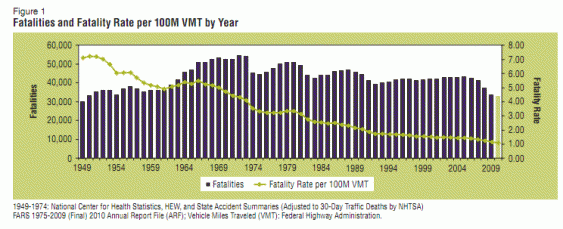The bad news: nearly 33,000 people in the US died in car crashes last year.
The good news: that was the lowest number of collision fatalities since 1949!! Take a look at the chart below, from the US Department of Transportation: the black lines represent the number of fatalities each year, and the green line represents fatality rates per 100 million vehicle miles. Total fatalities are at their lowest level since 1949, and fatalities per 100 million vehicle miles have now fallen to their lowest level since…well, probably since the car itself became a significant part of the nation’s transportation system. In 2011, collision fatalities per mile were about 1/7th as high as in the 1950s.
Clearly, driving has gotten a lot safer—which is perhaps the opposite of what one might expect, given the increased news coverage of traffic fatalities over time. The numbers have a few other surprises too:
- I’ve been obsessed for a while about recent signs that car travel has peaked over the last decade. But as it turns out, car crashes peaked back in the early 1970s, right before the first Arab oil embargo.
- Historically, the dips in fatalities all occurred when gas prices rose quickly relative to incomes. (See this chart for the trends in median wages vs. gas prices.) In short, expensive gas means safer roads.
- Generally speaking, when traffic declined, fatalities fell too—but the fatalities went down faster than traffic did. That’s actually what researchers expected: this report from the Victoria Transport Policy Institute, for example, cites evidence that a 10% decline in driving reduces crash risk by 17%. In short, small declines in how much you drive can have larger impacts on crash fatalities.
- Over the past few years, the decline in crash fatalities occurred even as new vehicles got smaller. For years, many people bought larger cars because they believed they were safer (though even at the time, the evidence for that was mixed at best). And some argued that efforts to improve vehicle fuel economy were increasing crash risks. But as it turns out, the best way to reduce crash fatalities is to reduce how much people drive—in which case, you can have safer roads even as cars grow more fuel efficient.



